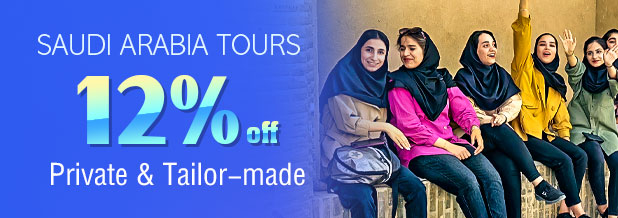Saudi Arabia Travel Guide
Basic Facts of Saudi Arabia
Location: in Arabian PeninsularArea: 2,250,000 sq km (869,000 sq mi)
Population: about 33 million
Language: Arabic
Currency: Saudi Riyal (SR)
Time Zone: UTC+3
Capital: Riyadh
Religion: Sunni Islam
Administrative Division:Saudi Arabia is divided into 13 regions including Qasim, Riyadh, Tabuk, Madinah, Makkah, Northern Borders, Jawf, Ha’il, Bahah, Jizan, Asir, Najran and Eastern Province.
Top Things to Do in Saudi Arabia
The word “Saud”, which means “happiness” in Arabian, comes from the name of the founder of the Kingdom, Ibn Saud. Together with the word “Arabia” which means dessert, Saudi Arabia means “happy dessert”. Founded on Sep 24th, 1923, the Kingdom of Saudi Arabia (KSA) is the largest country on the Arabian Peninsula, bordered by the Persian Gulf to the east, the Red Sea to the west, and shares border with Jordan, Iraq, Kuwait, Qatar, the United Arab Emirates and Yemen. It is home to the two holiest places for Muslims around the world, ie., Mecca and Medina. In Saudi Arabia, you can witness colorful and profound Islamic culture while traveling in holy mosques and enjoying the local food. You can also have a unique diving experience in the Red Sea in the country knowns as the Kingdom of Dessert.Top Destinations & Attractions:
Jeddah: Floating Mosque, The Red SeaRiyadh: Al-Diriyah
Mecca: Masjid Al-Harām (The Holy Mosque)
Medina: Al Masjid-e-Nabawi
Best Time to Visit Saudi Arabia
The best time to travel in Saudi Arabia is winter. Most part of Saudi Arabia has a desert climate. The temperature during daytime is very high and drops sharply at night. In summer, the average temperature can reach as high as 54 °C (129 °F). In winter the weather is mild as temperature is rarely below 0 °C (32 °F). Spring and autumn stand at about 29 °C (84 °F) .The amount of rainfall is extremely low throughout the year.The Asir region in the west belongs to etesian climate which sees more rainfall from October to March.
Transportation
The three major international airports are King Khalid International Airport in Riyadh, King Abdulaziz International Airport in Jeddah, and King Fahd International Airport in Dammam. They offer scheduled passenger service by commercial airlines.Saudi Arabia has public buses traveling to and from its neighboring areas including Bahrain, Abu Dhabi, Dubai, Egypt, Jordan, Syria and Turkey.
Saudi Arabia Travel Tips
Saudi Arabia has a very restrictive visa policy with three kinds of visa available: Hajj visa, tourist visa and work visa.Islam is the state religion and serves as the focus of cultural and social activities. Visitors should respect local conventions. Female visitors should pay special attention to the local restrictions on women’s behavior and dressing code to avoid possible offense against Islam.
The security condition has improved in recent years but visitors need to be vigilant of any potential security threats.

